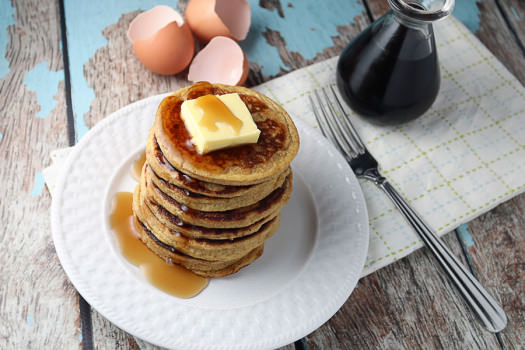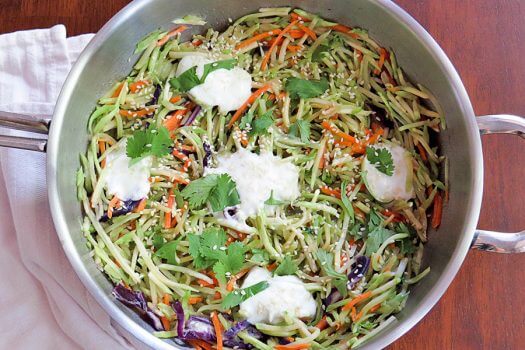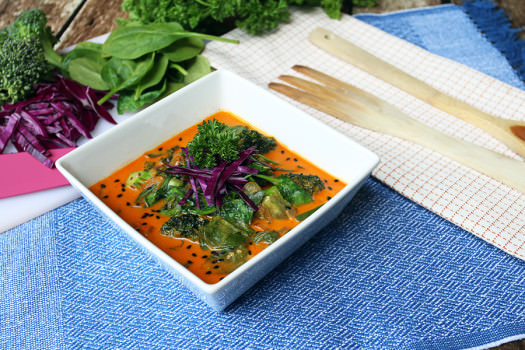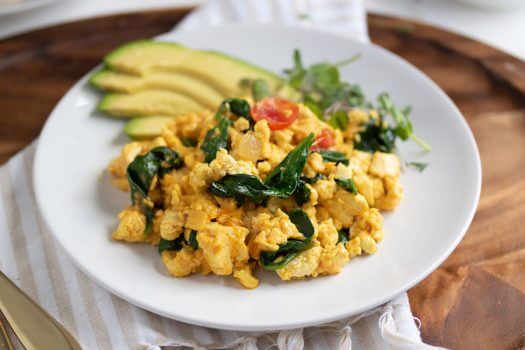Animal suffering, climate change, and health are three vitally important issues that can all be addressed with one solution — the vegan diet. At least, this is the idea that many health documentaries promote. The truth, however, is much more nuanced. Some may wonder if it is possible to follow a vegan keto diet. The short answer is, yes.
From a health perspective, some people have much better health when they go low-carb and eat some animal products, while others feel much better on a high-carb vegan diet.
A vegan diet is not the best diet for every health condition either. For example, people with conditions like obesity, type 2 diabetes, type 1 diabetes, Parkinson’s disease, Alzheimer’s disease, and epilepsy can be helped tremendously by the ketogenic diet, while a vegan diet doesn’t help nearly as much.
Does this mean that vegans should forget about ethical concerns and swallow down animal products like a supplement? Not at all.
If you find a high-carb vegan diet doesn’t work for you and a standard ketogenic diet may be what you need, you can combine the two to get the best of both diets.
An Overview of The Vegan Ketogenic Diet
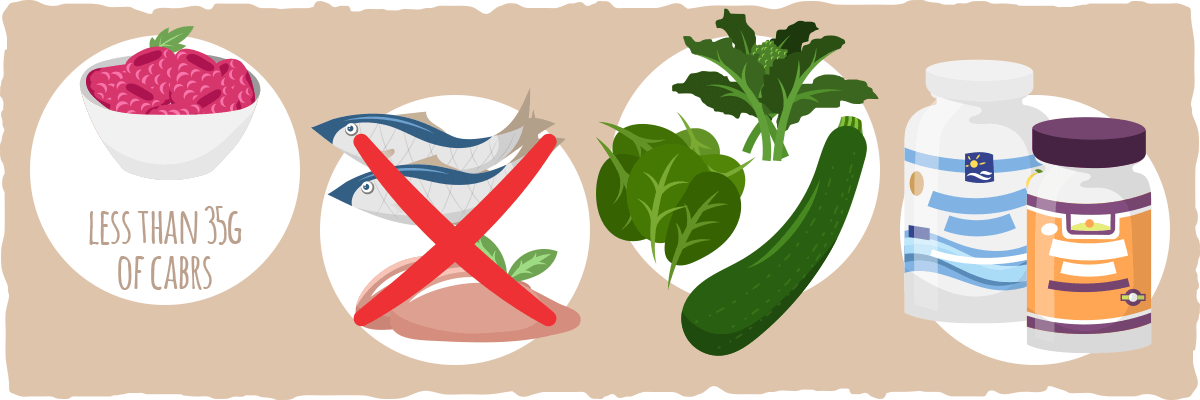
The vegan ketogenic diet is one of the most restrictive diets, but it is possible to pull it off while maintaining your sanity, decreasing animal suffering, and improving your health.
To implement the diet correctly, follow these rules:
- Limit your total carbohydrate consumption to 35 grams or less per day.
- Eliminate all meat, fish, dairy, eggs, and other animal products from your diet.
- Eat plenty of low-carb vegetables.
- Get at least 70% of your calories from plant-based fats.
- Consume around 25% of your calories from plant-based proteins.
- Supplement with nutrients that you may not be getting enough of (e.g., vitamins D3, B12, & B6, DHA & EPA, iron, zinc, and taurine).
- Use our keto calculator to determine how much fat, carbs, and protein you need to eat to meet your goals.
In short, a vegan keto diet will consist of roughly 70% fats, 25% protein, and 5% carbs, coming exclusively from the keto-friendly plant-based foods listed throughout this guide. This eating approach will allow you to reap the benefits of going vegan and keto with one diet.
The Benefits of Following a Vegan Keto Diet
A plethora of health benefits are associated with vegan and ketogenic diets, but no research studies examine what happens when we combine the two together. The closest thing to a vegan keto diet clinical trial was conducted in 2013, comparing a vegan, low-carb diet (also referred to as “Eco-Atkins”) to a high-carb, lacto-ovo vegetarian diet.
Though the vegan, low-carb group was allowed 26% carbs per day, their results were still significantly better than the high-carb group. After six months, they experienced 2 pounds more weight loss and greater reductions in LDL-C and triglycerides. These results follow in line with the benefits that researchers have found for vegan diets and keto diets.
Vegan diets, for example, have been shown to lower the risk of various chronic health conditions, including heart disease, diabetes, and certain cancers. People who adopt vegan diets also tend to lose more weight than those who include animal products like meat and dairy in their diets.
That being said, research on keto dieting has uncovered incredible benefits as well. Overall, the keto diet has been found to:
- promote significant weight loss
- decrease heart disease risk
- reduce insulin resistance
- enhance brain health
- aid in the treatment of various health conditions (including polycystic ovary syndrome, type 2 diabetes, certain types of cancer, Parkinson’s disease, and Alzheimer’s disease)
If you’d like to take a deeper dive into the research behind these benefits, follow this link. By combining these two approaches, you can experience the benefits of carb restriction, ketosis, and plant foods while each meal supports animal welfare and environmental health simultaneously.
If this sounds like something you’d like to try, let’s continue our journey with a vegan keto food list.
How to Limit Your Carbs on a Vegan Ketogenic Diet
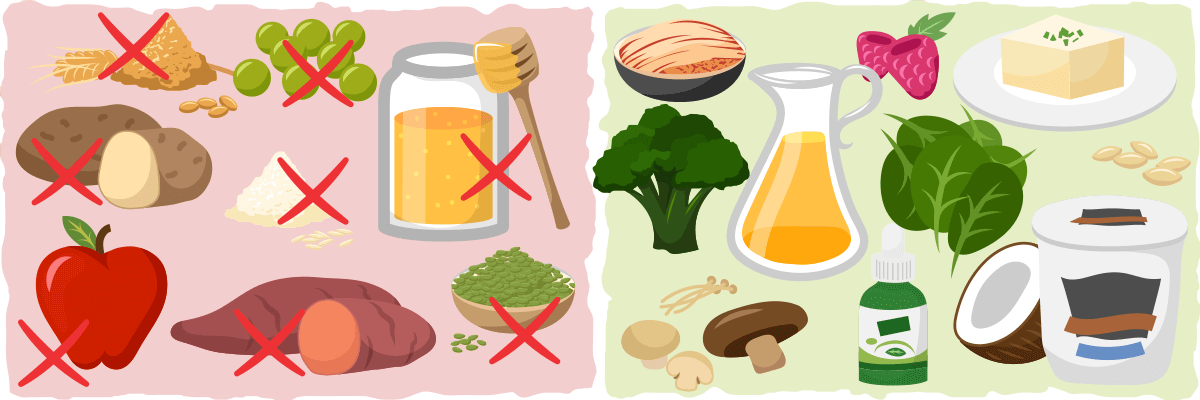
It seems hard enough to restrict carbohydrate consumption on a regular ketogenic diet, so how are you supposed to limit them on a vegan keto diet? Let’s start with a simple list of high-carb foods that you shouldn’t include in your diet at all.
Do Not Eat
- Grains – wheat, corn, rice, cereal, etc.
- Legumes — lentils, black beans, peas, etc.
- Sugar – honey, agave, maple syrup, etc.
- Fruit – apples, bananas, oranges, etc.
- Tubers – potato, yams, etc.
Now let’s look at low-carb vegan-friendly foods that you can eat on a vegan keto diet:
Do Eat
- Vegan “meats” — tempeh, tofu, seitan, and other high-protein, low-carb vegan “meats”
- Mushrooms — shiitake, king oyster, lion’s mane, etc.
- Leafy greens – spinach, kale, etc.
- Above ground vegetables – broccoli, cauliflower, zucchini, etc.
- High-fat dairy alternatives – unsweetened coconut-based yogurt, coconut cream, vegan cheeses, etc.
- Nuts and seeds – pistachios, almonds, sunflower seeds, pumpkin seeds, etc.
- Avocado and berries – raspberries, blackberries, and other low glycemic impact berries
- Fermented foods — Natto, sauerkraut, kim chi, etc.
- Sea vegetables — dulse, bladderwack, kelp, etc.
- Sweeteners – stevia, erythritol, monk fruit, and other low-carb sweeteners >
- Other fats – coconut oil, olive oil, MCT oil, avocado oil, etc.
For a more comprehensive breakdown of the calories, fats, proteins, and carbs in some of these foods, check out the ketogenic diet food list.
By eating the foods on the “Do Eat” list, you will be able to follow a vegan ketogenic diet and cover most of your nutritional bases. At first, however, it may be difficult to adapt to this new lifestyle with all of the low-carb and keto recipes that contain animal products. Luckily, there are some simple substitutions you can make that will allow you to “veganize” almost every keto recipe.
From Keto to Vegan Keto: Simple Vegan Alternatives
If you search through ruled.me (or any other keto website), you will see a ton of recipes featuring eggs and cheese. Even most of the desserts are filled with high-fat dairy.
Are there any keto-friendly vegan dairy and egg replacements? Why yes — yes there are.
Keto-Friendly Vegan Dairy Replacements
- Replace Milk with Coconut Milk. In recipes, you can substitute coconut milk in for regular milk in a 1 to 1 ratio.
- Replace Heavy Cream with Coconut Cream. You may have to blend in a bit of water or skim some water out of the container depending on the creaminess of the coconut cream.
- Instead of Butter use Coconut Oil or Vegan Butter. Coconut oil has a slightly lower melting point than butter and the same smoke point as butter, which makes it a good butter replacement. If you are not a fan of the flavor of coconut oil, look for vegan butter in your local health food store. Make sure the vegan butter doesn’t contain any hydrogenated oils because these oils increase the risk of heart disease tremendously.
- Replace Dairy-Based Cheese with Vegan Cheese. There are plenty of vegan cheeses on the market right now. If you want to avoid soy (for the reasons we will discover later), then you can find coconut, cashew, and other tree-nut-based cheeses. My personal favorite vegan cheese-making companies are Treeline and Miyoko’s Kitchen. Their cheeses are some of the best I’ve ever tasted. In fact, many people think that they are better than traditional dairy cheese. If Treeline or Miyoko’s Kitchen doesn’t have the cheese you are looking for, then try Follow Your Heart’s vegan cheese. Follow Your Heart is another company that makes almost every type of vegan cheese you could ever want.
- Instead of Cream Cheese have Vegan Soft Cheese. Treeline makes a cashew-based soft cheese that is delicious and savory, and it has almost the same texture as cream cheese. You can also make some creamy cashew cheese on your own with this recipe.
- Replace Yogurt and Sour Cream with Nut-Based Yogurt. At your local health food market, you will probably be able to find plain almond, cashew, or coconut milk yogurt. Just make sure it has no added sugars or hidden carbohydrates.

When it comes to buying keto-friendly vegan dairy products, make sure you are not getting any extra added sugar, hidden carbs, or unhealthy ingredients like hydrogenated oils. Some of these products may also have “gums” in them like agar agar or guar gum. These compounds are used to make the product creamier, and they are safe for most people. However, some people may get gastrointestinal discomfort from eating them, so look out for gums when switching to vegan dairy products.
The good news is that the availability of high-quality keto-friendly dairy alternatives is increasing rapidly. You can even have some of these products shipped directly to your house (e.g., Miyoko’s Kitchen ships direct to consumer).
Now that we have keto-friendly dairy alternatives covered, what about eggs? Eggs, egg whites, and egg yolks are an essential ingredient in many of the most tantalizing ketogenic diet recipes, should vegans ditch these dishes altogether?
Keto-Friendly Egg Substitutes
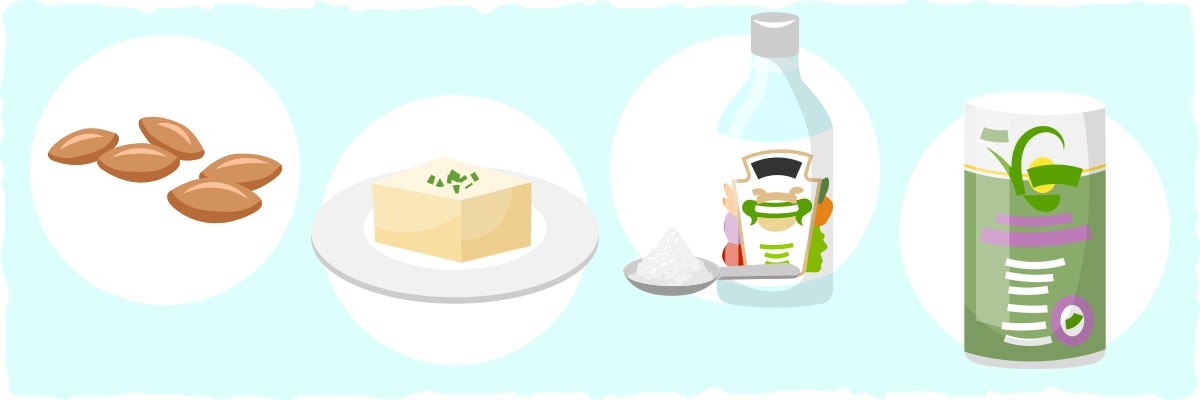
It’s frustrating to find mouth-watering, almost-vegan recipes — like Peanut Butter Pancakes and Coconut Chocolate Mocha Mug Cake — scroll down to the ingredients list and see that they require eggs.
Don’t fret just yet. You don’t have to give up on your delicious dreams. There are plenty of keto-friendly and vegan egg substitutes that you can try.
Flax Seed
Finely ground flax makes an excellent binder. It has a nutty flavor that works best in recipes for almond or coconut flour baked goods and pancakes. Use one tablespoon of ground flax seeds and three tablespoons of water to replace one egg.
Silken Tofu
Silken tofu is a softer, silkier form of tofu that makes a good egg and dairy replacement. It is relatively flavorless but tends to make baked goods dense, so it’s best used in brownies and some quick breads and cakes. 1/4 cup of puréed silken tofu can be used to replace each egg.
Baking Soda and Vinegar
This is a decent egg substitute for fluffier baked goods. Try using one teaspoon of baking soda mixed with one tablespoon of white vinegar for one egg.
Or you can skip the chemistry class and go right for the ready-made vegan egg replacements like these:
The Vegg
The Vegg is a 100% plant-based egg company. By using only natural ingredients, The Vegg has created products that simulate the taste, texture, and function of egg for use in your favorite dishes, all for about the same cost as real eggs.
Follow Your Heart’s VeganEgg
Follow Your Heart is another plant-based company that makes vegan alternatives of everything from cheese to mayonnaise. They even make vegan eggs!
Their VeganEgg is advertised as a vegan whole egg replacement that has the taste and texture of real eggs. You can use it to bake keto-friendly cookies, muffins, and cakes. The VeganEgg can also be used to cook up fluffy scrambled eggs and omelets as well.
There is, however, one downside to using egg replacements on the keto diet: they don’t contain as much fat or protein as a whole egg. This can make meeting your macros on the vegan ketogenic diet much more challenging.
That being said, there are plenty of vegan-friendly fats and protein-dense vegan “meats,” nuts, seeds, and supplements you can use to meet your fat and protein needs while minimizing carb intake.
These are all excellent vegan egg replacements. But you also have to consider that eggs are among the most nutrient dense foods. They contain all vitamins except Vitamin C, a wide range of minerals, and high-quality protein. When using egg replacements instead, you have to make sure you get sufficient nutrients. Read more about this in the section “The Downsides of The Vegan Ketogenic Diet” below.
How to Get Enough Fat on the Keto Diet For Vegans
Even though you can’t eat eggs, meat, butter, or dairy, you will still have an abundance of fat sources on the vegan ketogenic diet.
Here’s a brief list of the plant-based oils you can use and what you can use them for:
Coconut Oil
Coconut oil is an excellent oil for fat bombs, keto desserts, and cooking or baking at temperatures below 350 degrees Fahrenheit. It also provides you with plenty of keto-friendly fuel from long chain and medium chain saturated fatty acids.
Olive Oil
This oil contains a wide variety of healthy fats and has been found to have a plethora of health benefits as well. Feel free to use it as your primary cooking, frying, and baking oil on the vegan keto diet. A recent study found that it can withstand the rigors of high-temperature exposure without oxidizing and becoming toxic to the body.
Olive oil also serves a great flavor enhancer and healthy fat source for keto dieters, which makes it a great oil to use in salad dressings, sauces, and condiments.
Avocado Oil
Avocado oil contains more healthy monounsaturated fats than any other commonly used oils. It also has the highest smoke point of any other cooking oil (at 520 degrees Fahrenheit), which makes it an excellent option for cooking, baking, and frying.
Red Palm Oil
Red palm oil is an incredible source of Vitamins A and E. It has a mild carrot-like flavor, with a rich, buttery texture, and a slightly higher smoke point than olive oil and coconut oil. All of this makes it the perfect oil to prepare your vegan meats with and roast your nuts and seeds in.
However, you must be extra careful when purchasing palm oil. Many palm oil products are produced in a way that has devastating consequences for the environment, the wildlife, and the workers that help produce the oil.
For this reason, it is best to buy RSPO-certified or Certified Sustainable Palm Oil (CSPO) products. The companies that produce these products are approved by the RSPO (the Roundtable on Sustainable Palm Oil) for using sustainable practices that meet strict environmental and social criteria. By opting for RSPO-certified or CSPO products, you will be casting a vote for sustainable oil producers that are dedicated to protecting the environment.
The best way to find sustainable sources of palm oil is by searching through the members page of the RSPO directly.
MCT Oil
This oil is commonly derived from coconut and palm oil. It contains medium chain triglycerides, which are saturated fatty acids that skip normal fat digestion and go right to the liver where they are converted into ketones for fuel.
If you need an energy boost, add this flavorless oil to your salads, sauces, fat bombs, and hot drinks like coffee or tea. To learn more about this fantastic vegan keto oil, check out our comprehensive guide to MCTs.
Although these aren’t all the vegan oils you can consume, the oils listed above deserve special mention because of their versatility and health benefits.
That being said, high-fat plant foods will serve as your ideal fat source. These foods will help you meet your fat, vitamin, mineral, and fiber needs simultaneously, making them a vegan keto dieters best friend.
Here is a list of the healthiest whole food fat sources for vegans:
Avocado
High in monounsaturated fat, vitamins, minerals, fiber, and antioxidants, avocados are the perfect addition to any vegan keto meal. You can also make a keto-friendly vegan chocolate mousse dessert by blending avocado together with cacao powder, vanilla extract, and a low-calorie sweetener of your choice — delicious.
Nuts
Nuts are a healthy addition to any diet, and they are filled with different types of essential fats, vitamins, and minerals. Macadamias are arguably the best nut for keto because they have the highest amount of healthy monounsaturated fats and the lowest amount of net carbs and inflammatory omega 6 fats compared to other nuts.
Make sure, however, that you are aware of how many nuts you are consuming while you are on the vegan ketogenic diet. The carbs and calories from any nut can quickly add up and slow your progress.
Seeds
Pumpkin seeds, sesame seeds, flaxseeds, sunflower seeds, and chia seeds are another high-fat, healthy addition to the vegan ketogenic diet. They do, however, contain higher levels of inflammatory omega-6 fats, so don’t rely on them as a dietary fat staple.
Vegan Dairy Substitutes
The vegan dairy alternatives I mentioned previously also tend to be high in fat. However, make sure you check how many carbs are in each serving. Many vegan products contain unexpectedly high amounts of carbs.
With the help of these plant-based oils and fat-packed plant foods, you will have no problem getting the fats you need on the vegan ketogenic diet. The next macronutrient we will cover — and arguably the most difficult to get enough of on a vegan diet — is protein.
The Best Vegan Protein Sources for The Ketogenic Diet
Getting enough protein on the vegan diet to maintain health and muscle mass is hard enough without restricting carbs. When you combine the ketogenic diet and veganism, you take out many of the most potent plant-based sources of protein like legumes.
Without the help of beans, lentils, and peas, where can you get your protein from on a vegan ketogenic diet?
No need to worry, you have plenty of options:
Tofu
Tofu is an excellent substitute for meats like pork, chicken, beef, and fish. It’s made from soybeans and is high in protein and calcium.
Although it gets a bad reputation for being bland, tofu has an amazing ability to absorb flavors from spices and marinades. As long as you season or marinate it before cooking, it will be delicious. You can also make it as firm and chewy as meat by buying extra-firm tofu and pressing the heck out of it or freeze it and then press it.
Because tofu and, the next vegan “meat” on the list, tempeh are made from soy, it is important to notice how you feel after including them in your diet.

Soy contains goitrogens, which are plant compounds that can impair thyroid function. If you experience fatigue, cold sensitivity, constipation, dry skin, or unexplained weight gain as a result of upping your intake of soy-based products, then you should limit the amount of soy you consume (more on this and other vegan health concerns later in the article).
Tempeh
Tempeh is firmer than tofu and has a more grainy texture. It is made from fermented soybeans and is a good substitute for fish and ground beef.
One of the advantages of cooking with tempeh is that you don’t have to press it (like you have to with tofu). All you have to do is slice it, dice it, or grind it up in a food processor. If you find tempeh to be a bit bitter, try steaming it for a few minutes before using it.
Seitan
Seitan, also known as “wheat meat,” is a vegetarian meat substitute made from wheat gluten, soy sauce (or tamari), ginger, garlic, and seaweed. This vegan “meat” is high in protein, low in fat, and a good source of iron.
Seitan does, however, contain a lot of gluten. If you are sensitive to gluten in any way, then it’s best to keep seitan away from your taste buds.
Other Vegan “Meats”
There are a handful of vegan burgers and other “meats” that are available in most grocery stores. When deciding which one is right for you, make sure you carefully read the ingredients and nutrition facts.
If a product has a lot of potentially harmful ingredients or added sugars/carbs, then don’t buy it. Look for the simplest ingredients, the lowest carbohydrate content, and a good amount of fat or protein per serving.
The same rules apply when making your own vegan burgers at home. Many vegan burger recipes are packed with carbs from grains and legumes. Here’s a link to a great example of a low-carb vegan burger that you can try.

Nuts And Seeds
Many nuts and seeds are packed with protein, as well as essential vitamins and minerals.
The nuts and seeds with the most protein (per 100 grams) are:
- Pumpkin seeds with ~30 grams of protein
- Pistachios with ~21 grams
- Almonds with ~21 grams
- Sunflower seeds with ~19 grams
- Flaxseeds with ~ 18 grams
However, don’t let these numbers fool you. You must consider the carb content of these nuts and seeds as well.
- Pumpkin seeds have 46 grams of total carbs per 100 grams [7g net carbs]
- Pistachios have 28 grams of total carbs per 100 grams [18g net carbs]
- Almonds have 22 grams of total carbs per 100 grams [10g net carbs]
- Sunflower seeds have 20 grams of total carbs per 100 grams [6g net carbs]
- Flaxseeds have 29 grams of total carbs per 100 grams [2g net carbs]
And — although it’s technically a legume — peanuts deserve an honorable mention. They are packed with protein (~24 grams in 100 grams of peanuts) and relatively low in carbs (16 grams of total carbs in every 100 grams of peanuts).
If you are concerned about the carbs in these nuts and seeds, then limit their consumption and increase your protein intake with vegan protein powder instead.
Vegan Protein Powder
Vegan protein powders will be your secret weapon when it comes to meeting your protein needs on the vegan ketogenic diet.
It can be challenging to get all essential amino acids (the ones the body can’t make) from vegan protein sources.
High-quality protein powders provide complete protein to prevent any deficiencies.
However, this doesn’t mean that you have to slam protein shakes with every meal.
Try these strategies instead:

- Add a flavorless vegan protein powder to your meals. Pea protein isolate tends to be the cheapest and easiest vegan powder to use. You can add it to sauces, mix it with your vegan burgers, or make delicious coconut oil and coconut flour based protein bars with them.
- Make a low-carb smoothie with flavored vegan protein powders. Add a scoop of your favorite protein powder to one of Ruled.me’s smoothie recipes. The Blueberry Banana Bread Smoothie, McKeto Strawberry Milkshake, Cucumber Spinach Smoothie, and Blackberry Chocolate Shake are some delicious examples you can try.
When it comes to choosing the right vegan protein powder, there are many options. I have experimented with dozens of them, but always end up coming back to Garden of Life’s Raw Organic Protein or their Raw Organic Meal. Try these out for a good dose of protein, vitamins, and minerals.
The Takeaway — What To Eat on the Vegan Ketogenic Diet
It is easier than ever before to maintain a vegan ketogenic lifestyle. There are plenty of vegan dairy and egg alternatives available that will allow you to veganize most keto recipes.
Getting enough fat and protein on the vegan ketogenic diet shouldn’t be a problem either. Plant-based oils like coconut oil, avocado oil, MCT oil, and olive oil, as well as avocados, nuts, and seeds, will cover all of your fat needs. Moreover, to help cover your protein needs, make sure you have a vegan meat alternative, vegan protein powder, or high protein nuts and seeds with each meal.
Now that we have all of the vegan keto basics covered, let’s dig deeper into the diet with some tasty low-carb vegan recipes.
Vegan Ketogenic Diet Meal Examples
That’s right! These are keto-friendly peanut butter pancakes that are just like the real thing. Although this isn’t technically a vegan recipe, you can make it vegan with some simple substitutions.
*Replace heavy cream with coconut cream and eggs with an egg alternative from above (flaxseed meal may work well for these).
Vegan Sesame Tofu and Eggplant
This sesame tofu and eggplant recipe makes a wonderful light lunch or dinner and is surprisingly vegan. The eggplant is julienned then tossed with a spicy Asian style marinade before it’s cooked down into soft noodles. The tofu slices are crusted with sesame seeds then pan seared and caramelized with soy sauce.
In under 15 minutes, you can have a tender, crisp, broccoli slaw that’s warmed and dressed in classic Asian flavors. It’s so fast, and so easy, that this recipe is only three steps! Your entire family will be happy to see this on the table, even the ones who are not vegans or on keto.
*Use coconut or nut milk yogurt instead of goat milk yogurt.
For being ready in just under 20 minutes, this dish packs some incredible flavors. The vegan “fish” sauce definitely comes through and adds a more authentic flavor to all of it.
Crispy Tofu and Bok Choy Salad
Perfect for dinner or lunch, this salad takes tofu to the next level. The authentic Asian flavors come out so well in this dish that you’ll never crave Chinese food again.
Spicy Grilled Eggplant with Red Pepper
This eggplant dish is simple, filling, and delicious. Have it on the side with some vegan “meat” for an extra protein boost. Special thanks to Kalyn’s Kitchen for this recipe!
The beauty of this warm twist on a classic is that it is much more filling but with all of the traditional flavor. Because the salad base is fiber packed spinach, it satisfies the need to eat a hearty portion.
*Use vegan mozzarella from Miyoko’s Kitchen or Follow Your Heart instead of dairy-based mozzarella.
Vegan Portobello Steaks with Avocado Salsa
Do you miss the meatiness of steak on your dinner plate? Marinated and grilled portobello caps are the perfect vegan-friendly alternative. The marinade will hit your tongue with the right balance of favors, while the portobello provides your palate with a satisfying meaty texture.
With the right combination of seasonings and tofu, it is surprisingly easy to cook an egg-free breakfast scramble. You can even add some vegan bacon on the side by following one of the vegan-friendly bacon recipes below.
If you’d rather have something creamy and comforting for breakfast, this keto-friendly vegan porridge will hit the spot. All it takes is a few minutes, and you’ll find the taste and texture to be very similar to cream of wheat. Feel free to add your favorite nuts, seeds, berries, or other toppings from the vegan keto food list as well.
Vegan Cucumber and ‘Bacon’ Side Salad
This delicious keto salad makes a great vegan lunch or keto dinner side dish. With this recipe, you’ll also learn how to turn cremini mushrooms into a delicious vegan-friendly bacon alternative.
This keto-friendly vegan dessert will satisfy your sugar cravings. Scratch that — you’ll forget all about sugar after you indulge in one of these.
These are only a small sampling of the keto-friendly vegan recipes that are available on the internet. However, just by sticking with the sauces and suggestions from these eight vegan ketogenic meals, you will be able to create dozens of different delicious meal combinations.
Soon, you will be able to develop your own meal plan. Until then, here is a quick meal plan to help you out.
A Sample Vegan Keto Meal Plan

With this simple vegan ketogenic meal plan template, you’ll have enough recipes and leftovers for a full week’s worth of meals for one. If you’d like to get more creative, check out Ruled.me’s recipe page for some veganize-able keto dishes.
Day 1
Breakfast: Peanut Butter Pancakes and a McKeto Strawberry Milkshake with added vegan protein powder or make a keto-friendly smoothie with flavored vegan protein and MCT oil blended in.
Lunch: Crispy Tofu and Bok Choy Salad
Dinner: Vegan Portobello Steaks with Avocado Salsa
Dessert (optional): Coconut Peanut Butter Balls
Day 2
Breakfast: Vegan Keto Scramble
Lunch: Vegan Cucumber and ‘Bacon’ Side Salad
Dinner: Vegan Sesame Tofu and Eggplant with Warm Asian Broccoli Salad as a side dish
Dessert (optional): Chocolate Almond Avocado Pudding
Day 3
Breakfast: Vegan Keto Porridge
Lunch: Oven Roasted Caprese Salad
Dinner: Vegetarian Red Coconut Curry with Spicy Grilled Eggplant with Red Pepper, Parsley, and Mint as a side dish
Dessert (optional): Easy Keto Peanut Butter Cups (use coconut oil or cocoa butter to replace the regular butter)
There is one vitally important caveat with this vegan keto meal plan. It is hard to know exactly what your macronutrient ratios will be for each meal without knowing what vegan alternatives you use. The macronutrient counts on our recipes will not be 100% accurate for your meals.
It is also crucial that you are vigilant about meeting your fat, carb, and protein needs. The easiest way to do this and achieve the results you want is by using our personalized keto meal plan app.
The Downsides of The Vegan Ketogenic Diet

Although the vegan diet is comprised of more plant foods than any other diet, this doesn’t mean it is the healthiest diet. Plant foods simply do not contain enough of some essential nutrients we need to thrive.
Several studies, for example, have shown that both vegetarians and vegans are prone to deficiencies in B12, calcium, iron, zinc, the long-chain fatty acids EPA & DHA, and fat-soluble vitamins like A, D, & K2. Vegans and vegetarians may also suffer from hormonal issues if their bodies aren’t producing enough cholesterol and if plant compounds called goitrogens are impairing their thyroid function.
Fortunately, you don’t have to worry about these issues if you implement some of the following strategies:
- Eat as much real food as possible — limit your consumption of fake meats, overly processed soy products, vegan junk food, etc.
- Take a vegan DHA+EPA supplement.
- Properly prepare any seeds and nuts that you eat. Soaking and sprouting (when possible) help deactivate mineral-binding proteins that impair mineral absorption.
- Eat natto (fermented soy) or green leafy vegetables like kale to get enough Vitamin K2.
- Supplement with a vegan form of vitamin D3.
- Supplement with B vitamins, especially vitamin B-12.
- Eat some fermented foods like sauerkraut, kimchi, and natto to improve digestion and vitamin/mineral absorption.
- Keep your thyroid in good shape by eating iodine-rich foods like seaweed and increasing your selenium intake.
- Take a zinc supplement (like Zinc Balance) if you are experiencing zinc deficiency symptoms like dry skin or getting sick with a sore throat more often than usual.
- Supplement with one, two, or all three of the following compounds: taurine, carnosine, and creatine. Each one boosts health in a variety of ways, but they are not found in plant foods.
- Maximize iron absorption by having vitamin C-rich foods. (If your diet isn’t meeting your iron needs, you can also supplement with a heme-iron supplement.)
- Consider adding oysters, clams, and other bivalves to your diet. They are typically filled with so much B-12 and zinc that you may be able to cover your needs by eating them just once a week.
Can You Eat Soy on a Vegan Ketogenic Diet?
The impact that soy has on health is a hotly debated issue. After animal model research found that soy’s estrogen mimicking molecules may contribute to breast cancer, soy became one of the most demonized of all plant foods.
The research on humans, however, tells a different story. In fact, soy consumption is associated with a lower risk of breast cancer in women and prostate cancer in men.
Soy is even safe for women who have had estrogen-receptor positive breast cancer. Up to three servings per day of soy products, such as soymilk, tofu, and tempeh, were found to cause no adverse effects for these women. Soy consumption has not been found to have negative effects on men’s health or male sex hormone levels either.

All in all, soy looks like a safe food that most people will have no problems with. However, there may be a handful of individuals that may experience thyroid issues after increasing their soy consumption. This may happen because soy contains goitrogens — plant compounds that disrupt the production of thyroid hormones by interfering with iodine uptake in the thyroid gland.
If you are experiencing hypothyroid symptoms, like fatigue, cold sensitivity, constipation, dry skin, or unexplained weight gain, after increasing your soy consumption, then goitrogens may be the problem.
To improve thyroid function, decrease the amount of goitrogen-containing foods like soy and cruciferous vegetables (broccoli, kale, etc.) that you have in your diet and add a tablespoon or two of iodine-rich sea vegetables to each meal.
On the other hand, if you feel better when you are eating soy and cruciferous vegetables, then eat as much as you want (just make sure you are mindful of your carb intake).
When purchasing soy products, it is best to buy organic, especially if you want to avoid GMOs and the potential for increased pesticide exposure.
Putting It All Together — How to Thrive On The Vegan Ketogenic Diet
By following the vegan ketogenic diet, you can reduce your environmental impact, decrease animal suffering, and improve your health with just one lifestyle change. However, this dietary approach will require more hard work and dedication than most other diets if you want to get it right and reap all the benefits.
To implement the diet correctly, follow these rules:
- Limit your total carbohydrate consumption to 35 grams or less per day
- Eliminate all meat, fish, and other animal products from your diet
- Eat plenty of low-carb vegetables.
- Get at least 70% of your calories from plant-based fats.
- Consume around 25% of your calories from plant-based proteins.
- Supplement with nutrients that you may not be getting enough of.
Instead of meat, fish, cheese, dairy, and animal fats, you can have foods like:
- Tofu, tempeh, seitan, and other high-protein vegan “meats”
- Vegan egg replacements like The Vegg, VeganEgg, or homemade egg substitutes
- Coconut milk and other varieties of nut milk
- Coconut cream
- Coconut yogurt and other varieties of nut-based yogurt
- Vegan cheese (some of the best vegan cheeses are made by Treeline, Miyoko’s Kitchen, and Follow Your Heart)
- Vegan protein powders
- Plant-based oils like coconut oil, avocado oil, MCT oil, and olive oil
- High-protein nuts and seeds
Not sure how to combine these things into a meal? Use these vegan recipes as a guide:
*Replace heavy cream with coconut cream and eggs with an egg alternative from above.
*Use coconut or nut milk yogurt instead of goat milk yogurt.
- Vegetarian Red Coconut Curry
- Crispy Tofu and Bok Choy Salad
- Spicy Grilled Eggplant with Red Pepper, Parsley, and Mint
- Oven Roasted Caprese Salad*
*Use vegan mozzarella from Miyoko’s Kitchen or Follow Your Heart instead of dairy-based mozzarella.
If you need a protein boost, then add some plant-based protein to a keto-friendly vegan smoothie.
Not sure what keto-friendly smoothie to make? Try one of these:
- Blueberry Banana Bread Smoothie
- McKeto Strawberry Milkshake
- Cucumber Spinach Smoothie
- Blackberry Chocolate Shake
To thrive on the vegan keto diet, it is also important to cover any nutrient deficiencies you may incur from exclusively eating plant foods.
Here is a list of suggestions that will cover most of your needs:
- Eat as much real food as possible — limit your consumption of fake meats, overly processed soy products, vegan junk food, etc.
- Take a vegan DHA+EPA supplement.
- Properly prepare any seeds and nuts that you eat.
- Eat natto (fermented soy) and/or green leafy vegetables to get enough Vitamin K2.
- Supplement with a vegan form of vitamin D3.
- Supplement with B vitamins, especially vitamin B-12.
- Eat some fermented foods like sauerkraut, kimchi, and natto.
- Eat more iodine-rich foods like seaweed and increase your selenium intake.
- Take a zinc supplement (like Zinc Balance) if you are experiencing zinc deficiency symptoms like dry skin or getting sick with a sore throat more often than usual.
- Maximize iron absorption by having vitamin C-rich foods. (If your diet isn’t meeting your iron needs, you can also supplement with a heme-iron supplement.)
- Supplement with taurine, carnosine, and creatine for an extra health boost.
And most importantly:
- Make sure you are eating the right amount of calories, carbs, fats, and protein.
All of the effort you put into following the vegan ketogenic diet will mean nothing if you don’t get your macronutrients right.
To find what numbers you should aim for, plug your information into our keto calculator. Once you’ve done that, read through our beginner’s guide, so you know what to expect as you are entering ketosis.
Sources:
- The Benefits of The Ketogenic Diet — Ruled.me
- Vegetarianism and Nutrient Deficiencies — Weston A. Price Foundation
- 5 Vegan Substitutes for Eggs in Baking — The Kitchn
- Hypothyroidism (underactive thyroid) — Mayo Clinic
- Are Goitrogens in Foods Harmful? — Healthline
- Why You Should Think Twice About Vegetarian and Vegan Diets — Chris Kresser
- If everyone became vegetarian, would the planet actually be better off? — Popular Science
- 16 Nuts and Seeds High in Protein — HealthAliciousNess
- 7 Nutrients That You Can’t Get From Plant Foods — Healthline
- Ask the Expert: Soy — Physicians Committee for Responsible Medicine
- Antimicrobial, antioxidant and anti-inflammatory phenolic activities in extra virgin olive oil — Science Direct
- Characteristics of Red Palm Oil, a Carotene- and Vitamin E–Rich Refined Oil for Food Uses — Sage Journals
- Nuts, body weight and insulin resistance — Cambridge
- Nuts and Body Weight – An Overview — Research Gate
- The Properties of Lauric Acid and Their Significance in Coconut Oil — Springer Link
- Effects of medium-chain triglycerides on weight loss and body composition: a meta-analysis of randomized controlled trials. — NCBI
- MCT Oil 101 – A Review of Medium-Chain Triglycerides — Authority Nutrition
- Creatine — Examine
- Taurine — Examine
- Beta-alanine — Examine
- l-carnosine (β-alanyl-l-histidine) and carcinine (β-alanylhistamine) act as natural antioxidants with hydroxyl-radical-scavenging and lipid-peroxidase activities — Biochemical Journal
- Evaluation of Chemical and Physical Changes in Different Commercial Oils during Heating — Acta Scientific Nutritional Health
- 6 Science-Based Health Benefits of Eating Vegan — Healthline
- Effect of a 6-month vegan low-carbohydrate (‘Eco-Atkins’) diet on cardiovascular risk factors and body weight in hyperlipidaemic adults: a randomised controlled trial — BMJ

